Here you can find information about the importance of Guam’s reefs, condition, threats, and current and recommended management actions.
Why are Guam’s reefs so important?
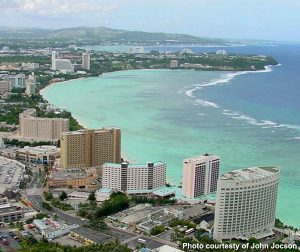
According to the 2008 State of the Coral Reef Ecosystems of Guam report, Guam’s coral reef resources are both economically and culturally important, providing numerous goods and services for the people of Guam. Among the multitude of goods and services that reefs provide are cultural/traditional use, tourism, recreation, fisheries, and shoreline/ infrastructure protection. A 2005 study conducted by a team of internationally renown researchers estimated that Guam’s reefs contribute approximately $127 million to the local economy each year. Guam’s reefs are also special in that they host an incredible variety of marine organisms. Despite the relatively small size of the island, a diversity of coastal habitats occur around the island, providing refuge for an amazing array of marine species.
Click here to learn more about the importance of Guam’s reefs
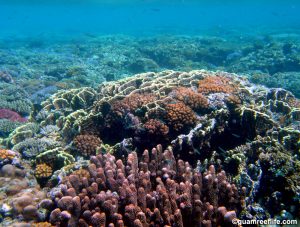
How healthy are Guam’s reefs?
The health of Guam’s reefs is variable, with some reefs supporting diverse, relatively healthy reef communities and others showing signs of severe degradation. But even a conservative assessment of the overall health of Guam’s reefs, especially in comparison to reefs in the past, would suggest that many of Guam’s reefs are, on average, in fair condition.Unfortunately, Guam’s reefs are not unique in this regard; indeed, the decline in the health of Guam’s reefs over at least the last several decades parallels the decline in the health of coral reefs across the world over this same time period. As a result of this decline, the ability of Guam’s coral reefs to provide important services to Guam’s current and future residents is compromised.
Click here to learn more about the health of Guam’s reefs
What are the main threats to Guam’s reefs?
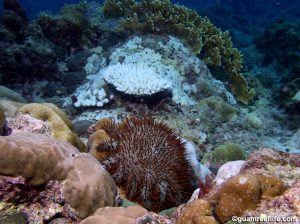
While there are multiple threats affecting Guam’s coral reefs, sedimentation, overharvesting of vulnerable and ecologically important fish species, and crown of thorns outbreaks have caused the most harm. Most of the threats currently affecting Guam’s reefs are local in origin, a result of the activities we do here on the island (or in the surrounding waters). But scientists around the world are warning of the threats to reefs posed by global climate change. These global-scale threats, including coral bleaching, ocean acidification, and sea level rise, are expected to challenge even the most healthy reefs and could result in the loss of much of the world’s coral reefs – including Guam’s. Indeed, in 2013 Guam experienced the worst coral bleaching event to-date, with most coral species bleaching and some succumbing to the heat stress. Guam’s reefs experienced yet another bleaching event in 2014, and,.according to a U. of Guam Marine Lab study, Guam lost approximately half of all of its staghorn coral between the 2013 and 2014 events. Guam narrowly missed another bleaching event in 2016 after warm waters that had settled in much earlier than normal had cooled just enough as a result of storm activity, and just as corals were showing signs of bleaching. It is unclear if the appearance of bleaching conditions during three out of four years is an anomaly, or if we’ve already arrived at a new normal of near-annual mass-bleaching events that some scientists’ predicted wouldn’t affect the world’s reefs for another 20-30 years. However, even if it is an anomaly, the current trajectory of human-influenced global warming of the earth’s atmosphere and oceans will mean that these high temperatures will arrive sooner rather than later.
Click here to learn more about the threats affecting Guam’s reefs
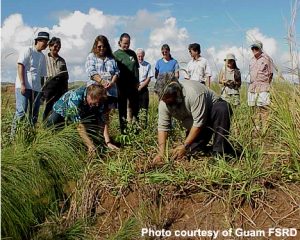 What is currently being done to address these threats?
What is currently being done to address these threats?
Local and federal agencies, NGOs, legislators, private enterprises, teachers, students and other concerned citizens continue to partner in the management and conservation of Guam’s reef resources. Various ambitious and creative projects are being implemented to address the primary threats to Guam’s coral reefs, including re-vegetation efforts, outreach campaigns, enforcement of the marine preserves, implementation of a comprehensive monitoring strategy, the strengthening of existing policies, the planned implementation of new policies, and others. These projects are but a few examples of people of Guam’s commitment to improving the health of their coral reef resources. The extension of sewage outfalls and the closing of Ordot dump will also contribute to a healthier reef system. The increasing level of community participation in cleanups, tree-plantings, and other activities, suggest that public awareness is increasing.
With the signature of Governor Felix Camacho in January 2006, Guam joined the Commonwealth of the Northern Mariana Islands, the Republic of Palau, the Republic of the Marshall Islands, and the Federated States of Micronesia in the Micronesia Challenge. The Micronesia Challenge, through which each nation/territory committed to effectively conserving at least 30% of its nearshore marine resources and 20% of its terrestrial resources, is a major step towards effective management of Guam’s natural resources. With the Micronesia Challenge, the participant nations/territories have committed to setting achievable conservation goals, identifying sustainable financing strategies, and providing an opportunity to further engage the community in natural resource management.
What else should be done?
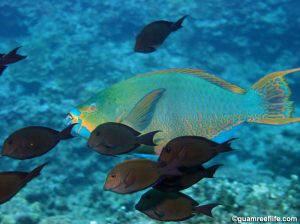
Despite some progress, such as with the success of the marine preserves, the health of Guam’s coral reefs continues to decline and the threats continue to mount. Clearly, more needs to be done – and fast. Among a number of policy and general strategy changes, three specific, priority projects recommended for immediate implementation include the use of stop-gap measures to greatly reduce soil erosion in southern Guam, adoption and implementation of a progressive land use plan and stormwater and erosion rules and reguations, and an island-wide ban on the use of monofilament gillnets and SCUBA and lights for spearfishing. Without a substantial reduction in the amount of sediment and other pollutants reaching the reef and the recovery of reef fish stocks, particularly algae-eating fishes like parrotfishes and surgeonfishes, the recovery of Guam’s degraded reefs, and the survival of even the healthiest reefs in the face of climate change, is in serious question.
Click here to learn more about recommendations for improving the way Guam’s reefs are managed
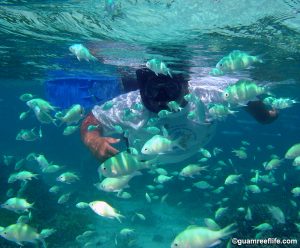
What can you do to help?
To quote Mahatma Ghandi, “you must be the change that you wish to see in the world.” Do not assume that someone else will take care of the problem for you – whether the local government, federal government, some non-profit organization, or whoever. Educate yourself about the issue, change the way you personally think and act with regard to that issue, and engage others to achieve the change you would like to see. Imagine a Guam with a vibrant, productive, healthy reef ecosystem and a people thriving next to this beautiful natural wonder, hold that vision in your mind, share it with others, and set forth to achieve it.
